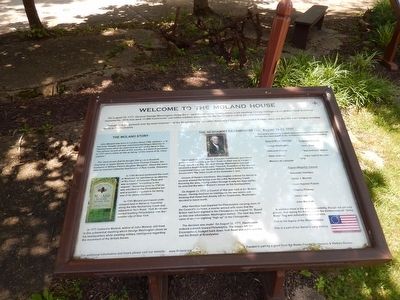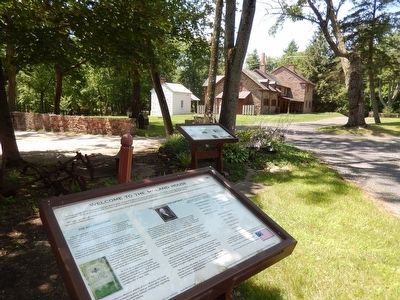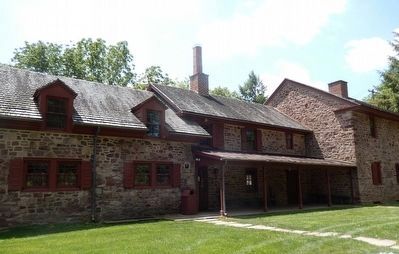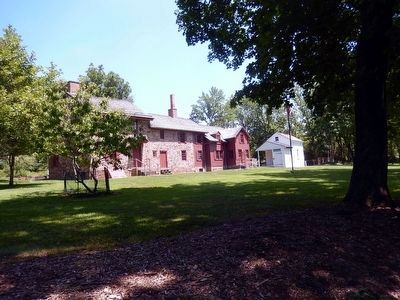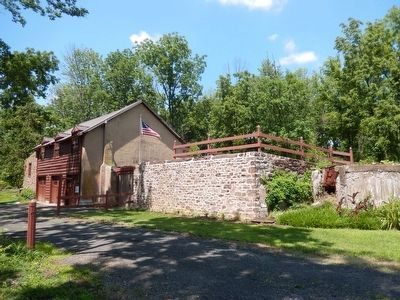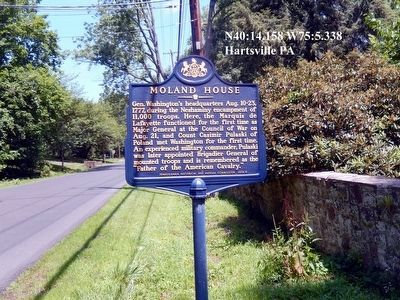Welcome to the Moland House
Though quickly glossed over by most historians of the Revolution, the so-called Neshaminy Encampment lasted thirteen days and was the third longest encampment in Pennsylvania.
The Moland Story
John Moland was born in London about 1700, studied law at the Inner Temple, and was commissioned King’s Attorney in Pennsylvania when he came here by way of the West Indies. The earliest record of him in this country is a deed of purchase in 1737 which refers to him as being “of the Island of St. Christophers”.
The deed shows that he bought 308 acres in Rockhill Township in Upper Bucks County from Thomas Freame, the husband of William Penn’s daughter Margaret. About the same time he married Catherine Hutchinson of New Castle, Delaware.
In 1740 Moland petitioned the court in Newtown for admittance as attorney of the Court of Common Pleas and was accepted “according to his request”. Sometime prior to 1742 he was admitted to the Philadelphia bar and acquired a reputation for being one of its ablest members.
In 1741 Moland purchased undeveloped
land in Warwick Township along the little Neshaminy Creek and adjacent to York Road. York Road connected bustling Philadelphia with the smaller city of New York.In 1777 Catherine Moland, widow of John Moland, still lived in this substantial dwelling which George Washington chose as his headquarters while awaiting military intelligence regarding the movement of the British forces.
The Neshaminy Encampment-August 10-23, 1777
On August 10, 1777 eleven thousand Continental and militia soldiers were marching up York Road on their way to Coryell’s Ferry (New Hope, PA). General George Washington had just received a dispatch from John Hancock, President of the Second Continental Congress. General William Howe’s British fleet and troops were fifty miles south of the Delaware Capes.
Unsure of Howe’s intentions, Washington ordered his forces to encamp around the bridge over the Little Neshaminy Creek. Knowing the area, having ridden through it only ten days earlier, he selected the widow Moland’s house as his headquarters.
On August 21, 1777 a Council of War was held at the Moland House. Having received no intelligence for two weeks and thinking that Howe had already left for Charleston, Washington decided to move north.
After Hamilton had departed for Philadelphia carrying news of the Council’s decision, a courier arrived with news that the British had
been sighted in the Chesapeake on August 14. Based on this information, Washington waited. The next day news came of another sighting “high up” in the Chesapeake.The decision was made! On August 23, 1777, Washington ordered a march toward Philadelphia. The troops left the Encampment, trudged back down York Road and subsequently met the British at Brandywine.
During the period there were many prominent Revolutionary individuals who were part of the Neshaminy Encampment including: General/Major Generals; *George Washington *Nathaniel Greene *Adam Stephen *Marquis de Lafayette; Brigadier General * Henry Knox *”Mad Anthony” Wayne *Peter Gabriel Muhlenberg; Captain/Major/Lt. Colonel *Alexander Hamilton *James J. Monroe *Count Kasimir Pulaski *John Marshall.
In addition there is the strong possibility, though not yet fully proven, that during the Encampment the thirteen-starred “Betsy Ross” flag was unfurled for the first time.
This is the legacy of the Moland House.
This is a part of our Nation’s early history.
Topics and series. This memorial is listed in this topic list: War, US Revolutionary. In addition, it is included in the Former U.S. Presidents: #01 George Washington, and the George Washington Slept Here series lists.
Location. 40° 14.181′
Other nearby markers. At least 8 other markers are within 3 miles of this marker, measured as the crow flies. Early Life on the Moland Farm (here, next to this marker); Moland House (about 300 feet away, measured in a direct line); Cross Roads (approx. 0.6 miles away); John Kulick and Tristan Smith (approx. 0.7 miles away); Independence Hall Stones (approx. 0.7 miles away); 9/11 NYC Emergency Responders' Memorial (approx. 0.7 miles away); Log College (approx. 1½ miles away); Warminster Community Park-Sandpiper (approx. 3 miles away).
Also see . . . Moland House Historic Park.
The Moland House, located in Warminster, Pennsylvania, is a historic site that played a significant role during the American Revolutionary War. It served as General George Washington's headquarters from August 10 to 23, 1777, during the Continental Army's retreat from the Battle of Brandywine. The house is a well-preserved example of colonial architecture and is now a museum and historical landmark that offers insights into this crucial period in American history. Visitors can explore its rooms and exhibits to learn more about its role in the Revolutionary War and the early days of the United States.(Submitted on January 16, 2024, by Brian of Newtown, Pennsylvania.)
Credits. This page was last revised on February 2, 2024. It was originally submitted on July 28, 2015, by Don Morfe of Baltimore, Maryland. This page has been viewed 509 times since then and 43 times this year. Photos: 1, 2, 3, 4, 5, 6. submitted on July 28, 2015, by Don Morfe of Baltimore, Maryland. • Bill Pfingsten was the editor who published this page.
